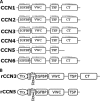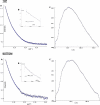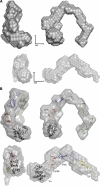First structural glimpse of CCN3 and CCN5 multifunctional signaling regulators elucidated by small angle x-ray scattering
- PMID: 21543320
- PMCID: PMC3121370
- DOI: 10.1074/jbc.M111.225755
First structural glimpse of CCN3 and CCN5 multifunctional signaling regulators elucidated by small angle x-ray scattering
Abstract
The CCN (cyr61, ctgf, nov) proteins (CCN1-6) are an important family of matricellular regulatory factors involved in internal and external cell signaling. They are central to essential biological processes such as adhesion, proliferation, angiogenesis, tumorigenesis, wound healing, and modulation of the extracellular matrix. They possess a highly conserved modular structure with four distinct modules that interact with a wide range of regulatory proteins and ligands. However, at the structural level, little is known although their biological function(s) seems to require cooperation between individual modules. Here we present for the first time structural determinants of two of the CCN family members, CCN3 and CCN5 (expressed in Escherichia coli), using small angle x-ray scattering. The results provide a description of the overall molecular shape and possible general three-dimensional modular arrangement for CCN proteins. These data unequivocally provide insight of the nature of CCN protein(s) in solution and thus important insight into their structure-function relationships.
Figures




Similar articles
-
Degradomic and yeast 2-hybrid inactive catalytic domain substrate trapping identifies new membrane-type 1 matrix metalloproteinase (MMP14) substrates: CCN3 (Nov) and CCN5 (WISP2).Matrix Biol. 2017 May;59:23-38. doi: 10.1016/j.matbio.2016.07.006. Epub 2016 Jul 26. Matrix Biol. 2017. PMID: 27471094
-
CCN3, a key matricellular protein, distinctly inhibits TGFβ1-mediated Smad1/5/8 signalling in human podocyte culture.Cell Mol Biol (Noisy-le-grand). 2018 Feb 28;64(3):5-10. doi: 10.14715/cmb/2018.64.3.2. Cell Mol Biol (Noisy-le-grand). 2018. PMID: 29506624
-
CCN3 and calcium signaling.Cell Commun Signal. 2003 Aug 15;1(1):1. doi: 10.1186/1478-811X-1-1. Cell Commun Signal. 2003. PMID: 14606958 Free PMC article.
-
Emerging role of CCN family proteins in tumorigenesis and cancer metastasis (Review).Int J Mol Med. 2015 Dec;36(6):1451-63. doi: 10.3892/ijmm.2015.2390. Epub 2015 Oct 23. Int J Mol Med. 2015. PMID: 26498181 Free PMC article. Review.
-
CCN proteins: multifunctional signalling regulators.Lancet. 2004 Jan 3;363(9402):62-4. doi: 10.1016/S0140-6736(03)15172-0. Lancet. 2004. PMID: 14723997 Review.
Cited by
-
Metabolic Effects of CCN5/WISP2 Gene Deficiency and Transgenic Overexpression in Mice.Int J Mol Sci. 2021 Dec 14;22(24):13418. doi: 10.3390/ijms222413418. Int J Mol Sci. 2021. PMID: 34948212 Free PMC article. Review.
-
The concept of the CCN protein family revisited: a centralized coordination network.J Cell Commun Signal. 2018 Mar;12(1):3-12. doi: 10.1007/s12079-018-0455-5. Epub 2018 Feb 22. J Cell Commun Signal. 2018. PMID: 29470822 Free PMC article. Review.
-
Connective tissue growth factor differentially binds to members of the cystine knot superfamily and potentiates platelet-derived growth factor-B signaling in rabbit corneal fibroblast cells.World J Biol Chem. 2015 Nov 26;6(4):379-88. doi: 10.4331/wjbc.v6.i4.379. World J Biol Chem. 2015. PMID: 26629321 Free PMC article.
-
CCN2/CTGF regulates neovessel formation via targeting structurally conserved cystine knot motifs in multiple angiogenic regulators.FASEB J. 2012 Aug;26(8):3365-79. doi: 10.1096/fj.11-200154. Epub 2012 May 18. FASEB J. 2012. PMID: 22611085 Free PMC article.
-
Connective tissue growth factor (CCN2) is a matricellular preproprotein controlled by proteolytic activation.J Biol Chem. 2018 Nov 16;293(46):17953-17970. doi: 10.1074/jbc.RA118.004559. Epub 2018 Sep 27. J Biol Chem. 2018. PMID: 30262666 Free PMC article.
References
Publication types
MeSH terms
Substances
LinkOut - more resources
Full Text Sources
Miscellaneous

